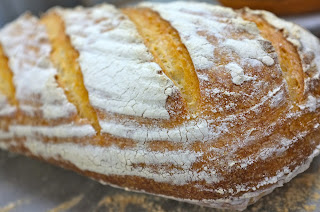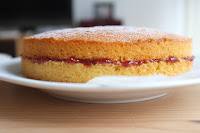Ohkubo Shokai are the suppliers of this European-designed Garnet oven in Japan.
In commercial terms it is a small oven (59W x 59D x 48H cm exterior), but it is able to bake to a professional standard and as such is attractive for small businesses. When I bought my stand mixer in Kappabashi the kind gents at Yoshida Kashi Douguten strongly recommended this oven to me and mentioned that test baking was a possibility at Ohkubo's test kitchen in Nerima-ku. The kitchen is big and has quite a bit of the equipment you'd need for a trial bake, such as weighing scales, whisks, bowls and sieves, hand/stand mixers, trays and oven gloves. You just take along the ingredients and any special equipment you need.
 |
| Test kitchen at Ohkubo Shokai |
I decided to test out a Victoria sponge cake, in the tradition of Mary Berry testing out home ovens when she worked for Bath electricity board, since it's quick and easy and I know exactly what they taste like from my home oven from the recent tests I've been doing.
 |
| Afternoon tea at Ohkubo Shokai |
I also made a couple of sourdoughs as I wanted to see how hot the Garnet oven could go, how well it would colour the crust and I especially wanted to try out the snazzy steam injection function.
If you want to order the steam-capable oven, you will need to have it plumbed into the water mains in your business. Steam is created when you press and hold the button which squirts water from the back of the oven which fizzles and turns to steam quite quickly.
For my test sourdoughs I didn't spritz them at all before they went in, the crust colour and opening of the slashes is largely down to the steam injection. They did fairly well despite one being a bit over-proofed and the other under-proofed thanks to the logistical challenge of trying get the dough ready for shaping and 2nd proofing upon my arrival in Nerima following a slog through hot and humid Tokyo with a heavy bag of dough. Eeek!
A peculiar feature of the Garnet is that the heating elements (there are 2) and fans are on the right hand side instead of the back, meaning less hot air is lost upon opening the oven door compared to regular ovens. The heaters are around the fans, and so hot air is convected through the oven chamber making preheating and cooling down comparatively fast. Something I was particularly impressed with was how quickly the loaves started to colour. My home oven sometimes has trouble getting a nice crust on anywhere but the top of my sourdough boules, but thanks to the posh convection system of the Garnet, they coloured evenly all over and quickly.
I used no baking stone or other sole-of-the-oven brick/ceramic tile tricks, yet the base of the bread was also baked and coloured nicely, despite the highest temperature on the dial being 230°C. (My home oven can go to 250°C, but only for 15 minutes, and it appears to be a different type of heat - more hot-spotty? - than the Garnet, where I found 230°C was hot enough and gave a better result than 250°C at home.)
The Victoria sponges also baked more quickly than in the home oven, and very evenly. There was a noticeable difference in the fine and smooth surface of the cakes, and in the moistness of the crumb. It was a more refined result than I usually get from my home oven, and this was particularly interesting to me.
Reader Ryan recently asked whether a professional oven was really 20 times as good as a domestic oven, considering that the Garnet ovens I'd been writing about were about that much more expensive being just above or below 400,000 JPY depending on whether you needed steam.
Before I did any test baking I asked the staff at Ohkubo the same question and was told that aside from the factors I'd come up with (a bigger footprint and 4 shelves = so much more output capacity, and the more robust design means that heavy daily usage is ok), the increased power along with the careful design of professional machines mean that the end result is of a much better quality and more consistent than a domestic oven.
 |
| 180°C on the dial - 180°C in the oven chamber |
Having tested the oven out myself, I can confirm that the baking experience and the end result from my tests today were much, much better than what I'm used to with my pretty-decent home oven. Whether it is indeed 20 times better, and whether that cost is justifiable for any particular business will depend on how important the baked goods are to the business, how efficient you need to be and exactly what is being made.
The nifty stand/rack storage space costs extra (about 70,000 yen), although you might be able to find a cheaper option. It's also possible to stack two of these Garnet ovens together - handy for small shop spaces in Tokyo.
Because the Garnet is smaller and cheaper than a lot of professional ovens, Ohkubo have sold some to customers for use in the home - however note that because the oven is 200v at 20 amps, it can't be plugged into a regular 100v domestic socket in a Japanese house. I gather you might need to have re-wiring done, but please speak with an electrician (and your landlord for permission if necessary!) as I'm not yet clued-up on what this would entail.
Test baking is available at Ohkubo Shokai by contacting them in Japanese or English via the form on their website to reserve a day to drop by. They have a number of interesting machines for large bakery businesses, but the Garnet oven is currently getting the most interest in terms of test baking.
 |
| Dough laminator, and other test kitchen equipment |

















































